1. FY06 PROGRESS FOR PEP-II
by John Seeman, Michael
Sullivan, and Uli Wienands
Appendix B Self-Evaluation FY2006
Return to Table of
Contents
General statements: PEP-II is a particle beam
accelerator which collides 1722 bunches of electrons
with 1722 bunches of positrons in two counter circulating
storage rings to produce continuous luminosity to make B
mesons in the BaBar physics detector. It is called a
B-Factory. Each bunch contains about 100 billion
particles. Each bunch collides on every turn of the
accelerator or about 136,300 times per second.
Construction and installation of PEP-II was completed
within budget in early July 1998. First collisions were
observed in late July 1998 that was two months ahead of
the final PEP-II DOE construction milestone. The BaBar
detector was installed in May 1999. PEP-II has been
delivering luminosity to BaBar nearly continuously over
the past seven years. PEP-II exceeded its design
luminosity (3 x 1033
cm-2s-1)
in October 2000 by achieving 3.30 x 1033
cm-2s-1.
Through steady progress, PEP-II has now exceeded, on
August 16, 2006, over four times its design luminosity
reaching 1.207 x 1034
cm-2s-1.
The peak integrated luminosity in 24 hours has reached
911 pb-1
which is seven times the design of 130 pb-1
per day.
End of PEP-II Run 5a in early FY2006:
The end of Beam Run 5a was from October 1 through 10
where PEP-II delivered luminosity to BaBar and did extra
accelerator studies to increase the peak luminosity.
This beam run in early FY2006 achieved several
milestones for the PEP-II program. PEP-II exceeded 3.3
times its design luminosity on October 9, 2005, by
achieving 1.003 x 1034
cm-2s-1.
This luminosity level corresponds to giving BaBar over 1
million new particle physics events every day! This very
high luminosity was reached using 1732 bunches with 2940
mA of positrons and 1740 mA of electrons, both record
beam currents at the time. The vertical and horizontal
beam sizes at the interaction region were about 4.0 by
125 microns, respectively. Furthermore, PEP-II delivered
728 pb-1
in one day to BaBar in early October 2004.
Installation period October 10 through November 15,
2005:
There was an installation period for PEP-II where
several new components were installed or upgraded and
the overall accelerator safety systems were recertified.
The original vacuum chambers in PEP-II (arcs and
straights) were designed to handle twice the LER current
and four times the HER current. However, to reach these
higher currents the interaction region vacuum chambers
need upgrading. Two of these chambers were exchanged.
Several NEG pumps were removed from LER interaction
region vacuum chambers which were being heated by beam
Higher Order Modes (HOMs). All safety systems were
checked.
PEP-II Operation:
The operation of PEP-II collider (Run 5b) started in
mid-November 2005, and ran until August 18, 2006. Over
100 fb-1
of data on and near the Upsilon 4S resonance were
delivered to BaBar in FY2006.
The luminosity increases over the past year have come
from several factors. Reducing βy*s from 11 to about 10
mm increased the luminosity by about 10%. The bunch
spacing has been changed from the “By-2” (a bunch every
second RF bucket) with mini-gaps to a full “By-2”
without mini-gaps. This configuration has only one gap
of about 15 missing bunches which is used as an abort
gap. This “By-2” spacing has some (anticipated)
parasitic crossing effects but the adverse affects were
measured to be below a few percent in the luminosity,
consistent with our beam-beam
computer simulations. The new bunch spacing allowed more
bunches to be collided which also allowed the beam
currents to be increased with constant bunch current.
The higher beam currents with the new RF stations are
now about 2950 mA in the LER and 1900 mA in the HER.
Both of these currents are world records for electron
and positron storage rings. The betatron tunes were
optimized near the half integer reducing the effects of
the beam-beam interaction.
Much work has gone into improving the optical magnet
lattice for both rings. This work has improved the
machine performance by reducing the “beta” errors around
the rings. The horizontal tunes have been moved closer
to the half integer resonance allowing even higher
beam-beam tune shifts. As a result, the specific
luminosity (luminosity divided by the product of the
beam currents) was at an all time high and was the cause
of the most significant gain in the luminosity this past
year. The optics-lattice group has done an excellent
job.
Trickle injection was a great improvement for PEP-II in
FY2004 and continued to improve in FY2005 and FY2006. An
example of a good day with trickle injection is shown in
the first figure below. Trickle injection for positrons
uses about ten injection pulses per second from the
linac, resulting in the positron current being stable to
about 0.1%. The HER injection of electrons is about five
Hz. The SLAC linac was designed to allow up to 40
injected positron pulses and also 40 electron pulses
each second in any order, although fewer pulses are in
fact actually needed. Thus, PEP-II has true trickle
injection with very steady currents and steady
luminosity. BaBar records better than 98% of the data in
the trickle running mode. The PEP-II and BaBar groups
are all very pleased with this improvement. All data
taking is now with continuous injection.
There were five interrupting events in Run 5b: four of
which needed vacuum intervention. 1) A gap ring for a
vacuum flange in the Low Energy Ring (LER) in PEP-II
Region 4 started to arc with the higher positron beam
current. This gap ring was changed, fixing the problem.
2) The high power bellows near the Q2 magnet shared
between the HER and LER ring in the interaction region
developed an arc near the HOM absorbing tiles and the
associated “Omega” RF seal. These two bellows were
removed and a new Omega seal used to fix the problem was
designed, built, and installed. 3) At high current two
Beam Position Monitor (BPM) button heads in the LER
physically dropped off near the interaction region. This
problem has been seen before in FY2005 and has been
carefully controlled since then. These button heads were
successfully removed. For a global cure, all the LER
BPMs in the interaction region and the dipole arcs will
be replaced or removed during the Fall 2006 down,
completely fixing this problem. 4) At high current an
expansion bellows unit and three Omega seals in the High
Energy Ring (HER) were damaged. These related problems
are being addressed during the Fall 2006 down. 5)
Finally, on August 18 during an accelerator machine
studies period, a special bunch pattern (By-4) was used
to study high bunch charge beam-beam effects and caused
overheating in a cable near the transverse feedback
kicker, subsequently causing a small cable fire. The
fire was promptly and safety extinguished. The cause of
the cable heating is now understood and will be fixed
before the next run starts in January 2007.
The beam run in the FY2006 achieved new records in all
performance milestones for the PEP-II program. PEP-II
exceeded 4 times its design luminosity this year (August
16, 2005) by achieving 1.207 x 1034
cm-2s-1.
This very high luminosity was reached using 1722 bunches
with 2900 mA of positrons and 1875 mA of electrons, both
record beam currents. The vertical and horizontal beam
sizes at the interaction region were about 3.8 by 130
microns, respectively. Furthermore, PEP-II delivered 911
pb-1
in one day to BaBar in July 2006. This rate is 7 times
the design delivered luminosity per day of 130 pb-1/day.
Thus, the luminosity delivery efficiency is excellent.
The total integrated luminosity delivered to BaBar in
FY2006 was 100.3 fb-1,
bringing a total so far of 410 fb-1
for the life of PEP-II.
The achievements of FY2006 for PEP-II can be seen in the
nine figures below. The first figure shows a good day
with trickle injection, stable beam currents and steady
luminosity. The next figure shows the peak luminosity in
each month since PEP-II started up with BaBar in May of
1999. Note that the PEP-II luminosity passed 1.2 x 1034/cm2/s
on August 16, 2006. The next figure shows the daily
integrated luminosity indicating PEP-II can deliver
solidly over 800 pb-1
per day. The next figure shows the daily average
luminosity each month with August 2006 being by far the
best month. The next figure shows the monthly integrated
luminosity for PEP-II since the collider started
operation FY1999. Over 19.3 fb-1
has been delivered to BaBar in a 30 day period in July
2006. The next plot shows the total integrated
luminosity with time over Run 5a and Run 5b indicating a
total of 153.8 fb-1
over that time. The following plot shows the total
integrated luminosity since May 1999 indicating that
PEP-II has delivered to BaBar over 410 fb-1.
The next table shows the operational records of PEP-II,
highlighting our peak luminosity of over 1.2 x 1034/cm2/s.
The final chart shows our integrated luminosity and run
time statistics for the four fiscal quarters of FY2006.
PEP-II installation in August and September 2006:
PEP-II entered a shut-down-maintenance period August 21,
2006, to do safety related activities in the tunnels and
to install new hardware for increasing the luminosity.
There are about a dozen projects associated with
increased luminosity. New HER Q4L, Q4R, and Q5R vacuum
chambers in the interaction region will be installed to
improve the HER vacuum pressure with beam current and
BaBar backgrounds. New LER vacuum chamber Q4R&L and
Q5R&L will be installed to allow high beam currents. A
beam spoiler will be reworked upstream of the LER abort
dump to protect the vacuum window from cracking from
high peak currents. A tenth HER RF station is being
installed to increase the ring’s current capability to
over 2 A. New beam position monitor (BPM) units will be
installed in the LER dipole arcs to improve their high
current capabilities. A HER vacuum transition chamber
will be changed with a higher power unit. A higher power
expansion bellows will be installed near a collimator in
LER in PEP-II Region 10 which is in a higher HOM power
region. New power supplies are being added to the HER
ring to allow the betatron tunes to be increased to
shorten the bunch length, which allows a smaller
vertical beta in the interaction region increasing the
luminosity. All of these tasks are planned to be
completed in the August through December 2006 shut-down.
The restart of PEP-II is anticipated for early January
2007.
PEP-II DOE Performance Measure:
The DOE HEP integrated luminosity measure for FY2006 for
PEP-II was 100 fb-1.
The actual integrated luminosity delivered by PEP-II in
FY 2006 was 100.3 fb-1
which meets the goal.
Figures for PEP-II performance in FY2006:
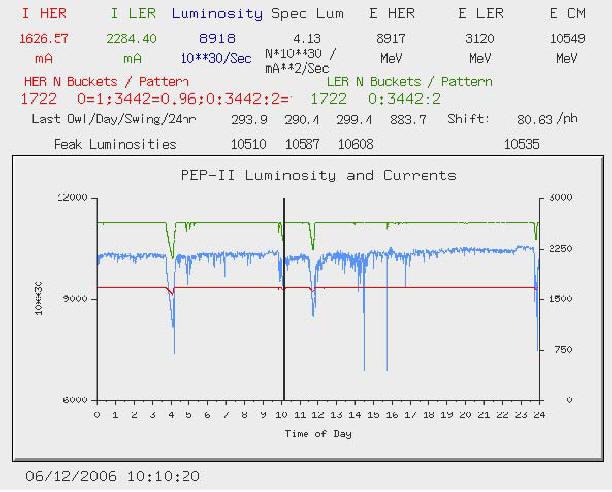
PEP-II beam currents and luminosity for 24 hours in July
2006 showing the stability of continuous (trickle)
injection and very high average luminosity approaching
1.1 x 1034.
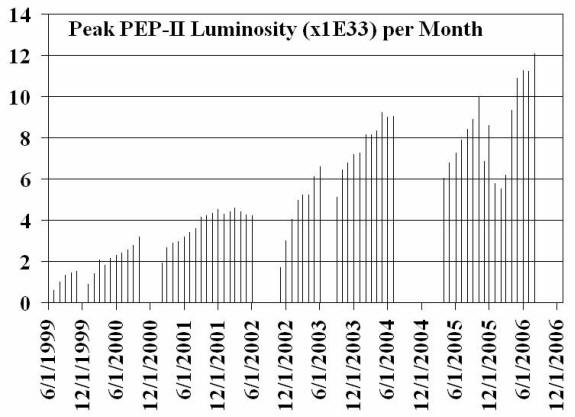
PEP-II peak luminosity in each month since May 1999.
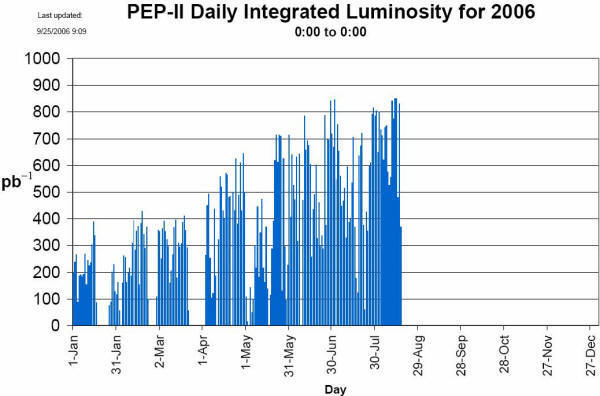
PEP-II Daily Integrated Luminosity for CY2006 showing
very strong progress.
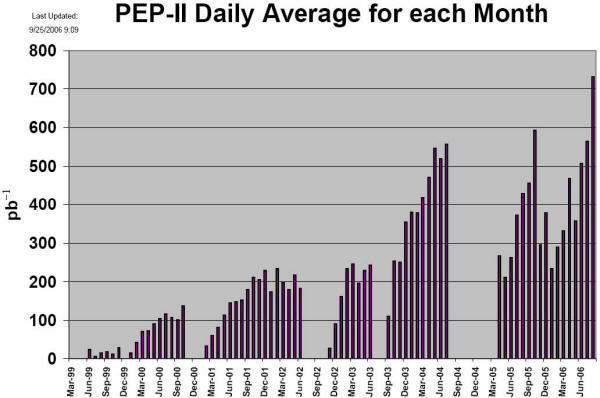
PEP-II Daily average integrated luminosity for each
month showing strong improvement at the end of the Run
5b.
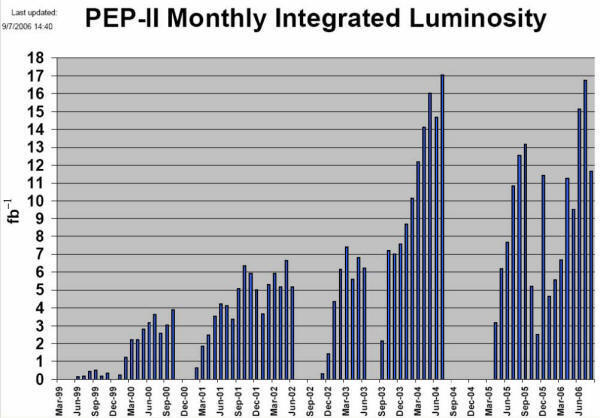
PEP-II integrated luminosity per month showing steady
improvement.
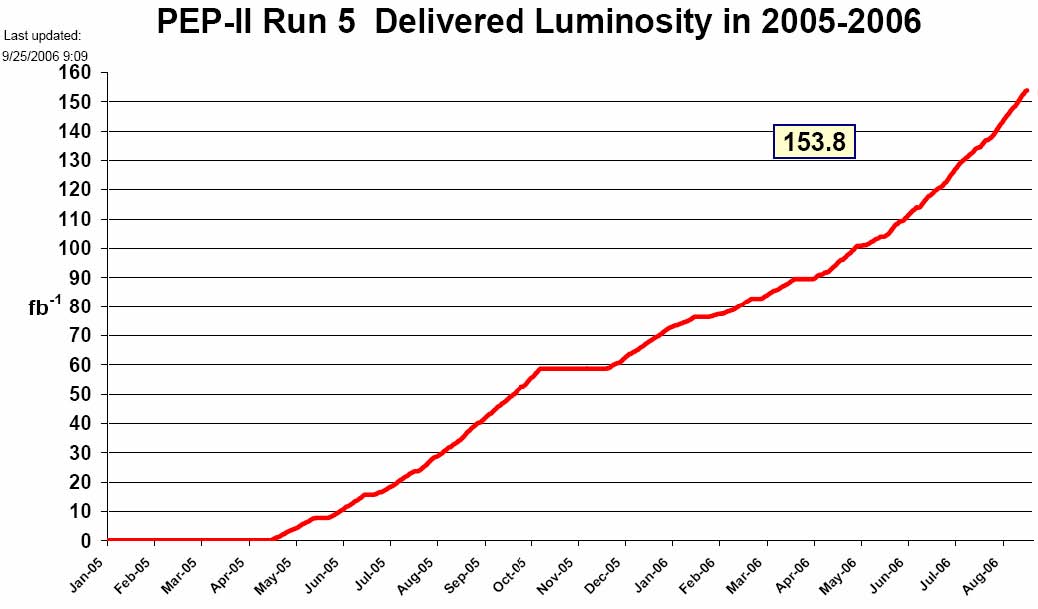
PEP-II accumulated integrated luminosity during FY2006.
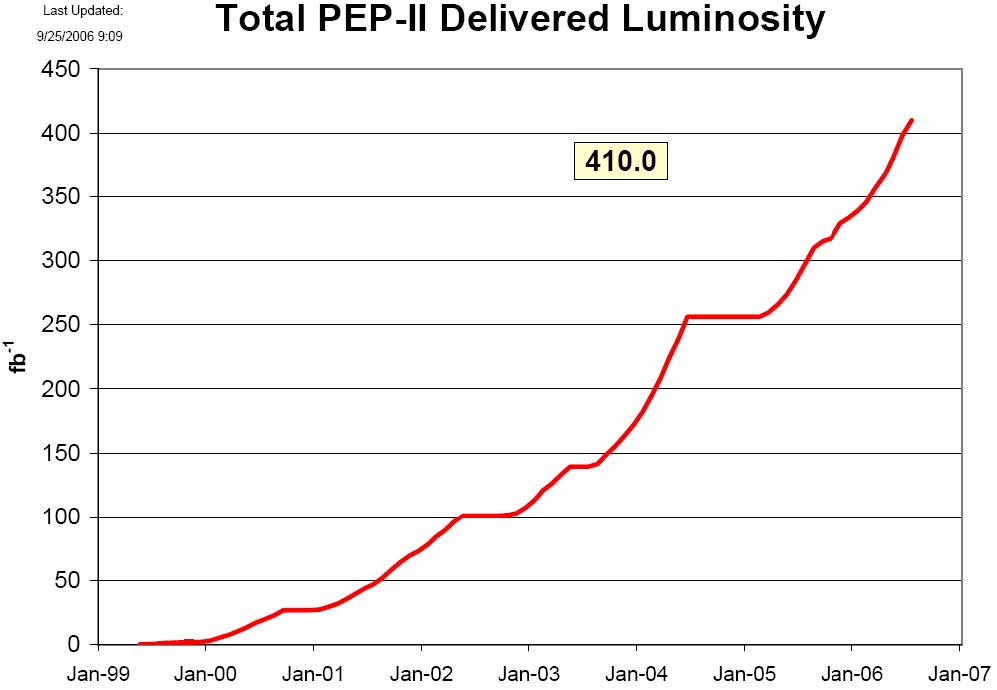
PEP-II accumulated integrated luminosity since May 1999.
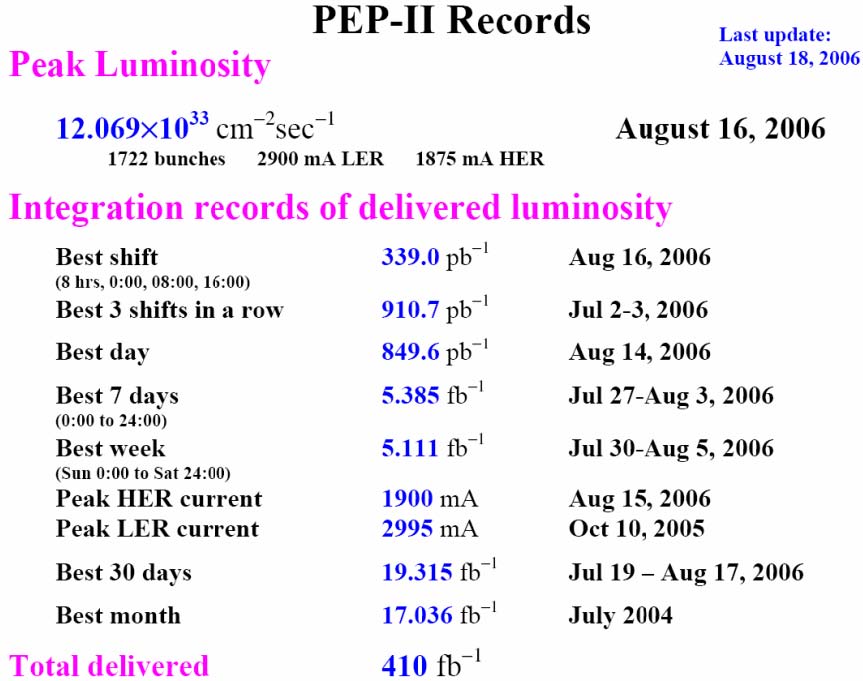
PEP-II overall performance records
 |